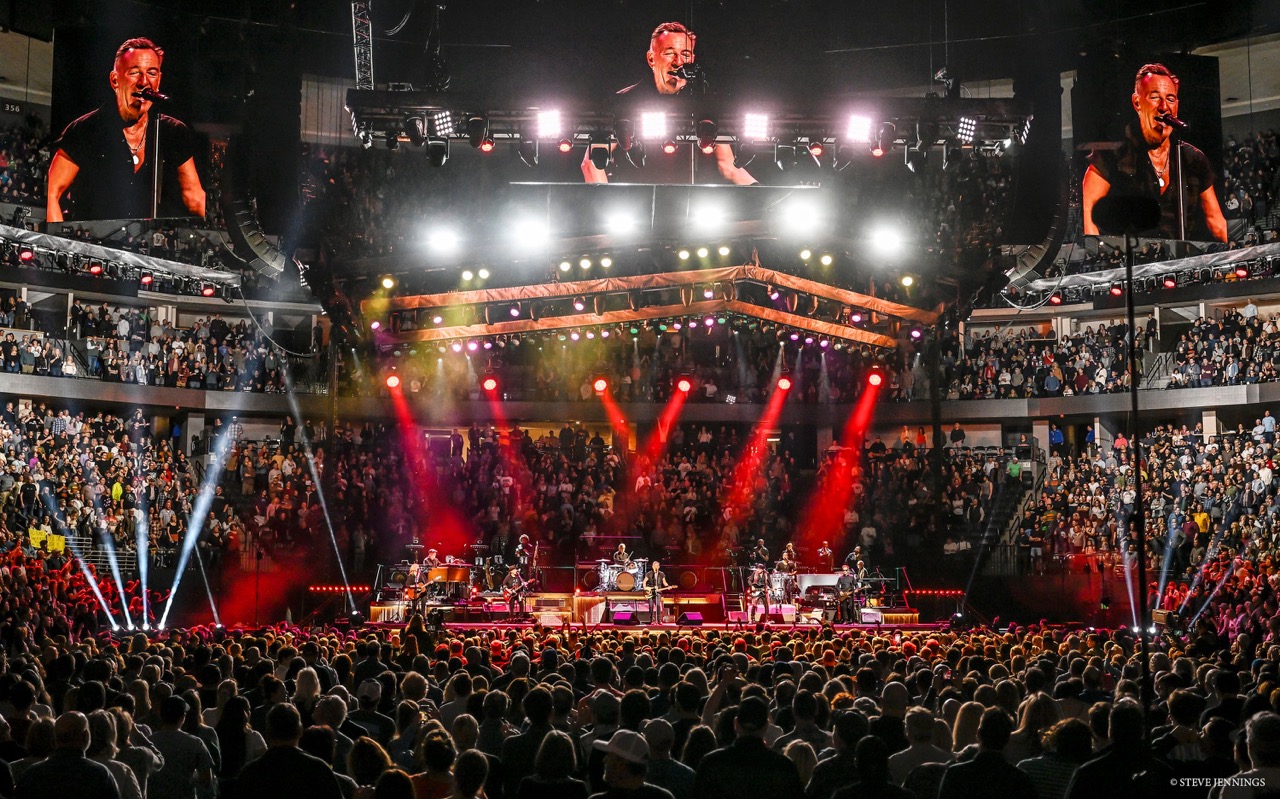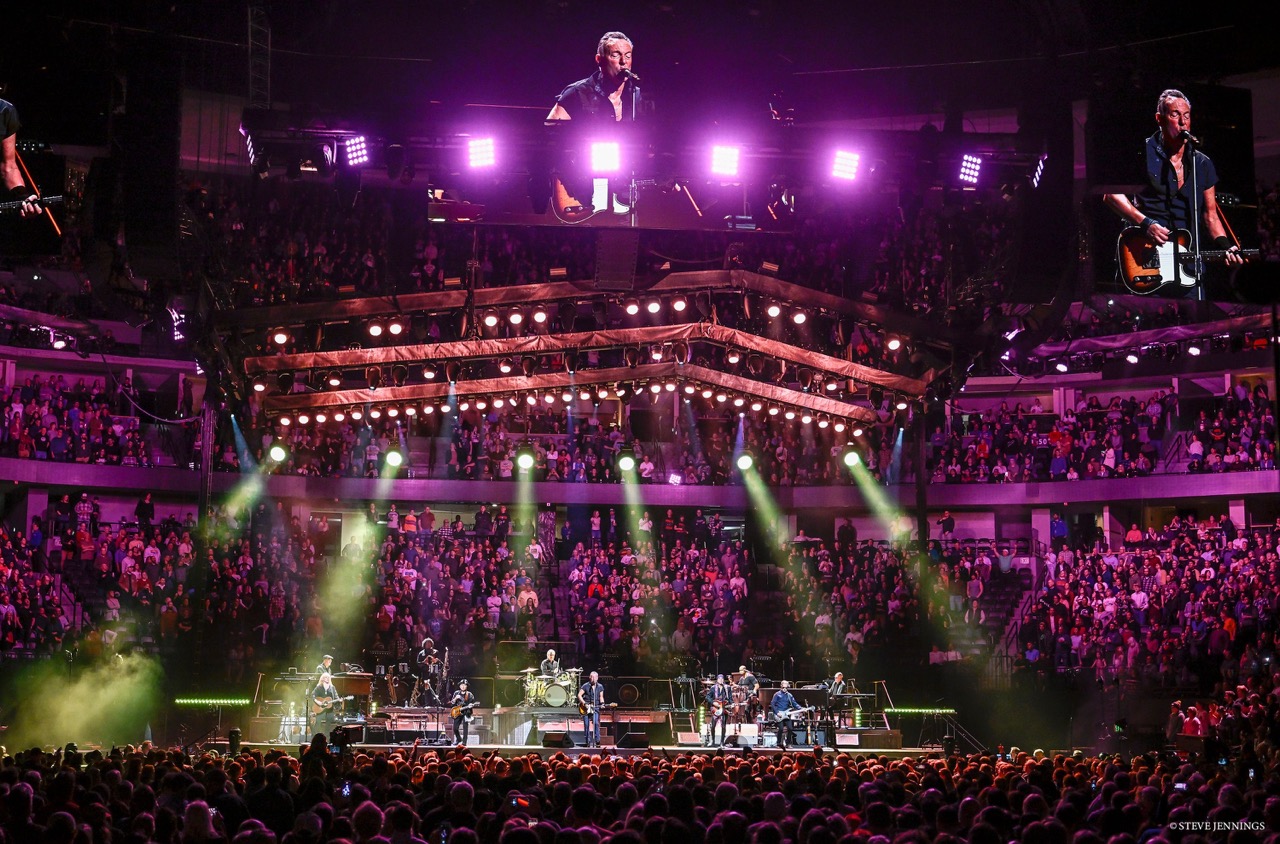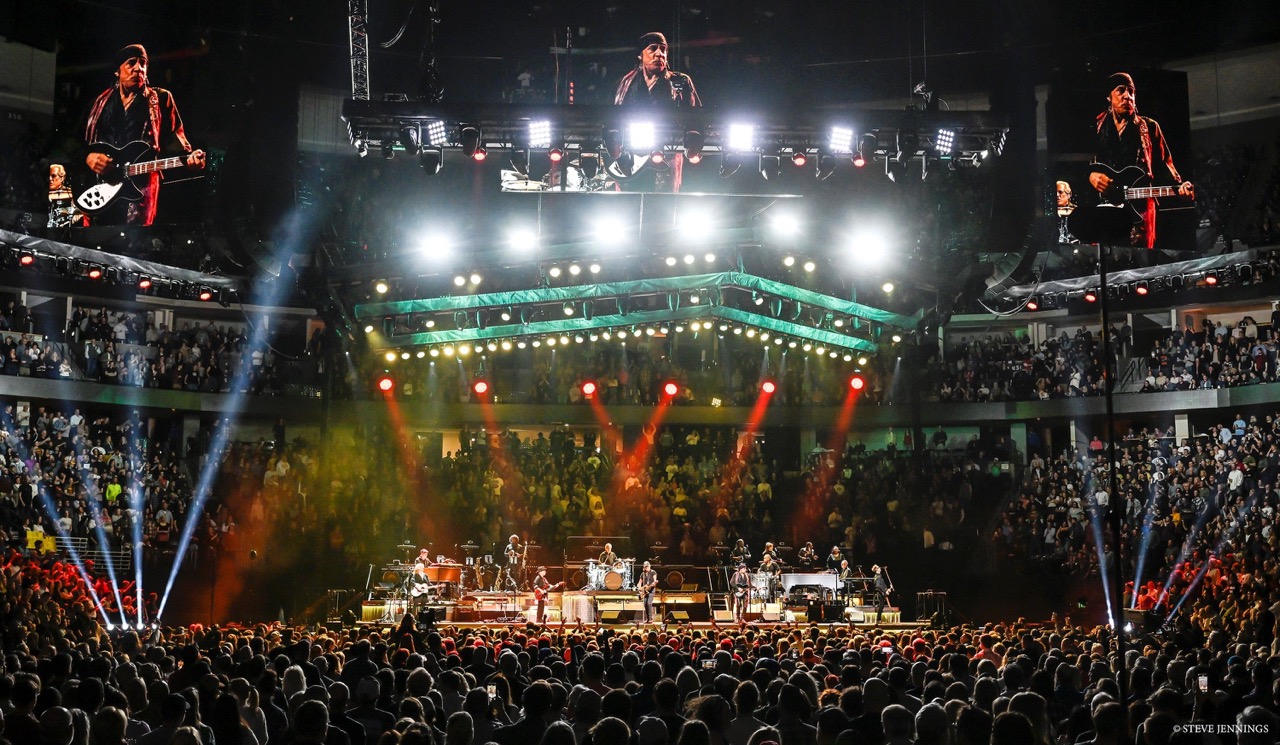Anatomy of a Rig – Jeff Ravitz Bruce Springsteen Tour
Posted on June 6, 2023
Magical things happen when an all-time great artist and performer hooks up with a legendary lighting designer. Just ask any of the fans who have packed arenas from Madison Square Garden to the LA Forum on Bruce Springsteen’s 46-city North American tour. Even those who have been to concerts by The Boss before have left these shows with a basket full of new memories to treasure, as the New Jersey-born superstar is performing with a passion that’s as fiery as ever, supported by a reimagined lighting design from Jeff Ravitz.
Springsteen’s longtime LD, Ravitz achieved a beautiful balance in his design for the current tour, maintaining the look and feel that fans love and expect from a Springsteen show, while also adding distinctive new twists with updated layered truss configurations, and light angles not seen on previous tours by his client.
To say that Ravitz has “balanced old and new” in this design would be neither completely accurate, nor fair. Instead, like his client, he has taken something timeless, and moved it forward in fresh directions, endowing it with the power to speak to people in new and evolving ways. This quality on the part of the artist and his LD is one of the things that makes every Bruce Springsteen show a unique and unforgettable experience.
Taking a break from his busy schedule, Ravitz gave us an inside look into how this special chemistry is working on the 2023 Bruce Springsteen tour
This was the first tour in six years for Bruce. Can you tell us a bit about how and when you learned about it and generally what was the creative brief? Was there an intent to create something different for this tour?
“Not surprisingly, Bruce was quite prolific in the years after the 2016-2017 River anniversary tour. There was his Broadway show and the Western Stars movie. Then, just as the pandemic enveloped us, he released the Letter To You album, showing he’s as much in the game as ever. So, there we were in the middle of the worldwide shutdown, and his inner gears began to turn as he thought about his next move.

“In 2021, Bruce’s tour director, George Travis, called to plant some seeds about a full-blown E Street tour. We chatted for quite a while about ideas and options. George is the first one to know we’d be crazy to fix something that’s not broken. And in most respects, the performances would have the same structure as Bruce’s shows dating back decades. The band would be in the same positions onstage, playing lots of the classic songs with the familiar arrangements the crowd expects. But there would be lots of new music too, as well as the addition of horns, vocalists and a percussionist, as have occasionally been on a few tours in the past.
“Plus, with the realization that in the last six years, even die-hard Springsteen fans have been exposed to so many new types of exciting visuals on TV and at live concerts, we knew we had to bring the tour a few more steps into the 2020s. Therefore, the brief I received was “keep the essence of a Springsteen/E Street Band show but make sure the audience are aware of a new and current look as soon as they enter the building.”
You’ve said that you wanted to create sculptured layers for this tour from upstage to downstage. How and why did you do that?
“Starting with the ‘why,’ I just think that layering is more pleasing to look at. It’s about accentuating the depth and dimension of the performance space. We see better and perceive better when we see dimensionally, and “layering” is just another way to express that: foreground, middle and background. But our stage, despite its multi levels of runways, ramps and risers, isn’t very high, and so there’s almost no background behind the performers. My mission was to maximize any chunk of vertical surface to create more background, or at least the illusion of that.
“I’ve always tried to light riser and runway facades as separate entities from the people and instruments onstage, but I had to do most of it from the overhead rig or from the sides. I was frustrated that the band would inevitably walk into that light and it wasn’t very pretty. So for this tour, I pitched the idea of incorporating lighting into the stage and risers to light the set and facades in a more effective way and to define the shapes and edges as a stronger visual element. It also would give us more tools to cue with, and a better way to tie in the colors and rhythms happening above on the lighting system. And most importantly, it would create another layer of background.
“Also, on the far upstage runway, I added more lighting to the handrail that’s there to protect Bruce from ‘falling overboard.’ Those lights, facing straight out, have helped to create a low but powerful wall of light that beefs up the background look with more color and more visible sources, which today’s audiences are accustomed to seeing.

“The last bit of layering is the audience, themselves, as well as the fixtures that light them, which extend the ‘source’ look from the stage to the house. So…band, risers & facias, audience, and the rig itself are all involved.”
The way you angled the truss for this tour was a departure from what you’ve done in the past. How is that? What was your design vision?
“I’m well aware that in the world of concert design, there’s nothing revolutionary about a truss that also serves as a visual element. But it’s a downright avant-garde concept for this show! We know the culture of this group is based on its bar band roots and Bruce’s identification with this genre. A bar has lights on a pipe screwed to the ceiling. And the ground rules dictate that we call less attention to the rig and more to the way the lighting supports the music. But with our new mission to have a fresh and contemporary look –within limits — I began playing with ways to frame the stage differently. I had a few early versions which were nice looks but impractical. As I played with the proportions, I found something that felt really right, simple, and different. Instead of level, straight trusses, which are very useful in creating a grid over the stage, I broke the truss into two sections of two-thirds/one-third to create a gentle peak at the break point. The off-center angle was appealing as being not too predictable, and it gave the entire rig more height and scale.
“We also added truss covers—not borders, but masking pieces that were fit to the truss. This gives us a surface to light so the trussing truly becomes part of the overall look, but not with the usual exposed truss structure vibe.
Bruce’s music is diverse and he’s been known to add songs to his set list at the last moment. How did you ensure your rig was versatile enough to account for this?
“We have a lot of visual elements to use in various combinations. Each band member is covered with individual lights to pick them out of the darkness in any way that works best for that song. Then, we have a system of wash lights to create a base look, a system of spot fixtures to add texture and movement, and we have multiple layers of scenic and audience lights. Every light moves and changes color, which gives us lots of combinations.
“That being said, we do have an enormous number of songs programmed, and Todd, the tour LD, and Brad, the operator on console number 2, can reference any of those songs quickly when Bruce throws a curveball. And if it’s a song that hasn’t been programmed or updated, there are many busking cue lists that they can choose from, all of which were created to fit one or more types of songs. What else can we do?? It seems to work for the show…not so much for blood pressure levels!”
How did you account for this show having a 360ﹾ stage?
“Just to clarify, by 360°, we’re not saying the stage is in the center of the arena. We set up at the usual end-of-arena position, with audience seated behind the stage because Bruce enjoys seeing the crowd everywhere he turns. Those people back there, wrapping around to the front, have an extraordinary view of the show, and Bruce and the band play to them a lot, especially when they go on the upstage runway, which gets them really close to those sections. That rear audience also becomes a background element, and when they’re on their feet adding energy to the show, it’s like having 500 dancers!”
Looking at your creative process, can you tell us what was the first design element you worked on when putting this rig together? Why?
“I had to get the layout of the system defined before I could advance to the next step. But in the back of my mind, I always knew the way I needed to light the show and where fixtures must be to provide the best angles. So, as the truss configuration was developing, that process was influenced by the actual lighting requirements.
“The truss arrangement wasn’t just over the stage. I added several positions over the audience in places we’ve never used before. These all needed to be approved by the tour director since there was a concern some of them might block sightlines, cost more money, and take more crew.”
On the other end of the spectrum, what was the last piece of the design puzzle that came together for you?
“I want to say it was the built-in scenic lights, which came right after the audience lighting. I did a lot of research to find the right products for all of those and then we had to figure out how to incorporate them into stage. This also had huge financial ramifications for the purchases, the build, and the crew to manage all these extras on a daily basis, so it needed to be honed and perfected.”
Were there any last minute changes?
“Surprisingly few. Once on another tour, Bruce made radical changes to the band’s positions during rehearsals. That was a real “stop everything and lower the trusses” moment. But not for this tour. The percussionist was added a bit later in the process, which required some additions and juggling. But it was a positive thing because while working out the percussion lighting, I was prompted to rethink and improve a few other things. I made a few changes after seeing the rig in pre vis. But no changes other than to the set list, which is typical.”
What was the most challenging thing about this project?
“It’s hard to pick! The two big technical challenges were the integration of so many set-mounted fixtures and built-in lights, and the sixteen to twenty remote follow spots and controllers. Those two elements are like a mini lighting system all by themselves! But between TAIT, our set construction company, and our Christie Lites team, both challenges were successfully handled.
“I think my biggest challenge, always, is time management and working on the truly never-ending set list. We did get a preliminary list, and then another and another. Songs are added and subtracted from the show. What that means is that we are often chasing our tails. It’s possible to spend a night programming a song that ultimately never makes it into the show, at the expense of not having programmed a song that actually is in the show. Of course, a song can be programmed on the road during the tour if the song appears to be a permanent set list addition. However, that is not necessarily the best way to deliver high quality work.
“Our workflow is to prioritize programming the new songs. Then the old numbers need to be updated to work with the new system. Even after weeks of pre vis and onsite programming, we still fall way short of completion. That can be frustrating. But on the other hand, this is at the very heart of Bruce’s magic, and the show just wouldn’t be the same without the edge-of-your-seat anticipation that something unexpected is about to happen. Like I said earlier, I prefer “unpredictable”, even though it can be like a banana peel on the floor.”
Any other comments?
“We’re incredibly lucky to be working with such talented and larger-than-life performers. We do better when we have a terrific show to light. I’m only too aware Bruce and the E Streeters would deliver a smashing show with only house lights on, which actually happens, famously, during the encores. But I do think our lighting elevates the experience.
“My job can’t be done alone. I’m surrounded by professionals who are creative and technical problem-solvers, starting with Todd Ricci, the touring LD, Mike Appel, our programmer, the entire Christie Lites squad, and everyone on the production that, one way or another, help us make it happen. We consider ourselves a team, and the traveling crew are like a family. I come and go since I don’t travel full time with the show. I’m in awe of the job they do against the odds of limited time, finicky electronics, and the need for round-the-clock endurance. I am enormously grateful.”